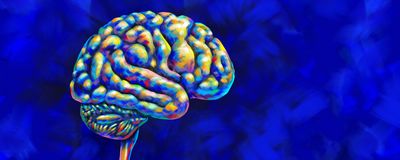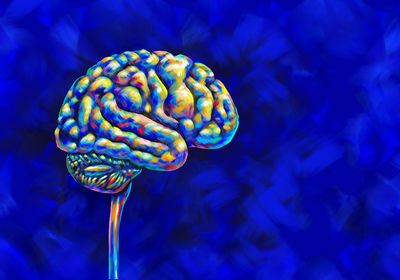ABOVE: Researchers from the Institute for Psychedelics and Neurotherapeutics at the University of California, Davis used optogenetics and single-cell RNA sequencing to identify psychedelic responsive neurons in the brain’s medical prefrontal cortex and mimic the antianxiety effects of psychedelics while bypassing their hallucinogenic effects. ©iStock, wildpixel
The anxious brain is a watchman on steroids, wired to perceive danger at every turn. This extreme vigilance activates biological stress responses that exacerbate anxiety, creating a vicious loop. Breaking this cycle is key to treating anxiety, but traditional pharmacotherapies are moderately effective and have significant side effects.
The recent interest in the benefits of psychedelics for psychological disorders has scientists tapping into their anxiety-reducing properties to devise new trip-free therapies. In a recent study published in Science, researchers from the Institute for Psychedelics and Neurotherapeutics (IPN) at the University of California, Davis studied the neurobiology of psychedelics in a mouse model to pinpoint how they cause hallucinations and also crush anxiety.1

“We've been trying to understand how psychedelics do what they do to the brain and then use the information to generate optimized therapeutics…safer versions of psychedelics [including non-hallucinogenic variants] that are more scalable and would be accessible to a broader patient population,” said David Olson, a chemical neuroscientist at IPN and coauthor of the study.
Olson collaborated with Christina Kim, a neuroscientist and bioengineer at IPN, to explore which neural circuits in the brain mediate the hallucinogenic and antianxiety effects of psychedelic drugs. “We were interested in how psychedelics modulate a particular set of neurons in a brain region called the medial prefrontal cortex. This region [has] been implicated in driving antianxiety-like effects, and also hallucinogenic-like side effects of psychedelics,” Kim said.
Kim, Olson, and their teams examined changes in the basal levels of anxiety in mice. Anxious mice are less interested in exploring open spaces and engage in compulsive behaviors, such as burying foreign objects in their bedding. The researchers exposed mice to the psychedelic 2,5-dimethoxy-4-iodoamphetamine (DOI) and tracked their behavior. DOI lessened the anxious behaviors but also caused the mice to twitch their heads, a sign of hallucinogenic-like activity.
“We saw both of these effects right away after the drug administration,” said Kim. “If we waited for six hours, we found we could still see the antianxiety-like effects, but we no longer saw those head twitch responses.” This signaled to the researchers that the mind-altering and antianxiety effects of psychedelics may be mediated by different neural circuits in the brain.
They used scFLARE2, a molecular tagging technique, to mark prefrontal cortex neurons that were most active following DOI administration, then reactivated these cells the next day using optogenetics. By that time, the psychedelic drug was inactive, and the researchers were able to mimic the antianxiety effect. They also used RNA sequencing to home in on the cell types that psychedelics activate. “One neat thing about the tagging tool is that once it tags a DOI-activated cell, it basically marks that cell with a foreign transcript,” Kim said. “We could treat animals with DOI, do the tagging, and then microdissect out the neurons and perform single nucleus RNA sequencing, and get all of this information about the molecular identity of cells, and whether they had a cellular activity history of being activated by the transcript, by the psychedelic drug.”

In addition to serotonin 2A receptor (5-HT2AR) neurons, which mediate hallucinogenic and neuroplastic effects of psychedelics, the researchers identified additional interconnected neuronal networks in the medial prefrontal cortex that are involved in reducing anxiety. While the 5-HT2AR neurons may kick start the response to psychedelics, the antianxiety effects depend on downstream activity in other networks.
Steven Barker, a neurochemist and professor emeritus at Louisiana State University, who was not involved in this study, expressed enthusiasm for the work. “In terms of psychedelic therapeutics, it’s a real benefit to the field. One of the drawbacks in psychedelic therapy right now is the need to monitor the patient. You can't give them a bottle of pills and send them home,” he said. “By eliminating the hallucinogenic effect, they can create new drugs that have beneficial effects without having to monitor the patient during administration. We wasted so many years not examining these compounds, it's really been a scientific travesty.”
Olson is hopeful about the future of psychedelic neurobiology research. “Psychedelics have been around for a long time, but we are really only now entering an era of modern neuroscience where we have the tools necessary to start unraveling some of these mysteries,” he said.
- Muir J, et al. Isolation of psychedelic-responsive neurons underlying anxiolytic behavioral states. Science. 2024;386(6723):802-810.




